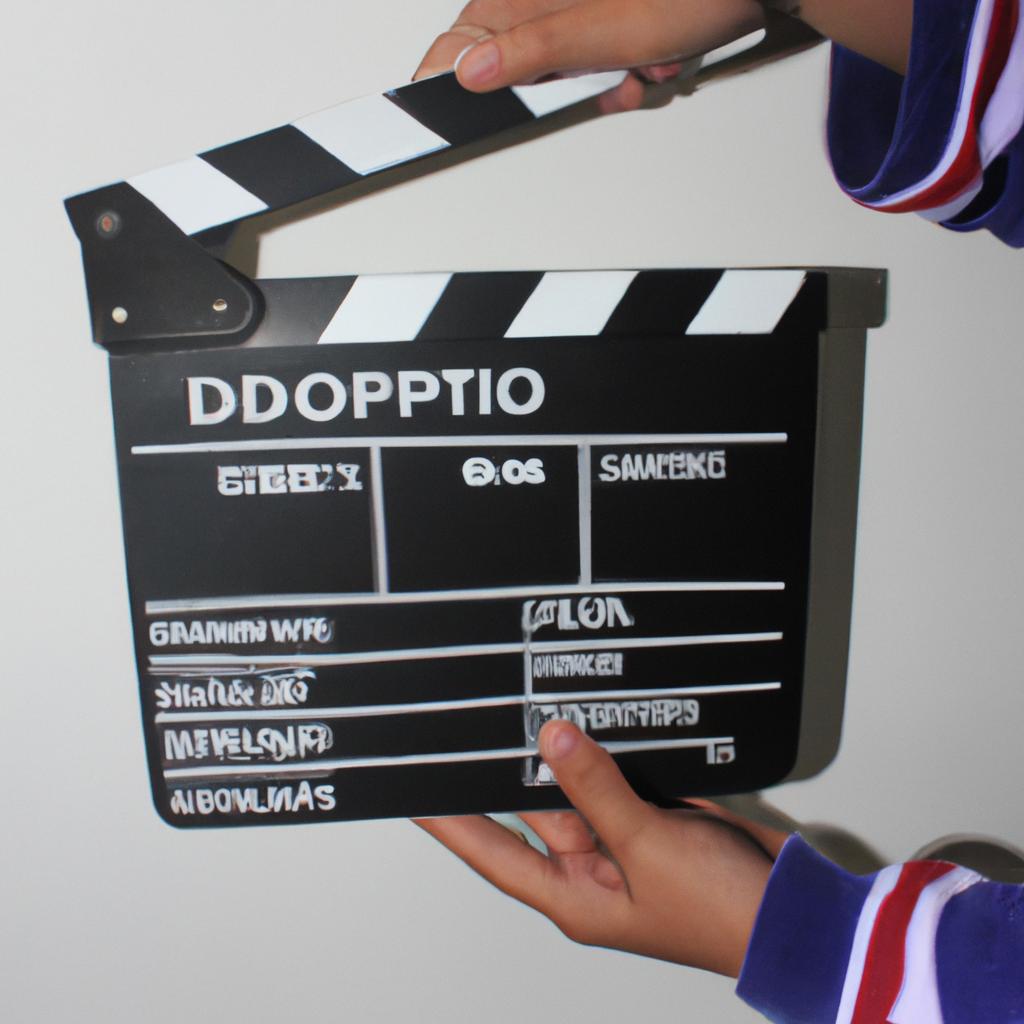In today’s world of arts and movies, filmmaking has become an increasingly popular form of artistic expression. However, the process of bringing a film from conception to completion is often fraught with financial obstacles that can hinder even the most talented filmmakers. This is where grants for filmmakers come into play, providing much-needed funding and support for aspiring and established artists alike.
One such example is the Sundance Institute Documentary Fund, which offers grants to documentary filmmakers around the globe. With a mission to amplify diverse voices and stories through non-fiction cinema, this fund has supported numerous groundbreaking documentaries over the years. From thought-provoking social commentaries to intimate personal narratives, these films have shed light on pressing issues while captivating audiences worldwide.
Grant programs like the Sundance Institute Documentary Fund are just one facet of the vast landscape of film funds available in the world of arts and movies. These funds serve as vital resources for filmmakers seeking financial backing for their creative endeavors. In this article, we will explore various grant opportunities offered by organizations both big and small, delving into their application processes, eligibility criteria, and success stories. By shedding light on these funding sources, we aim to empower filmmakers with knowledge and tools necessary to navigate the intricate web of financing options in pursuit of their filmmaking dreams.
Grant programs not only provide financial support, but they also offer a platform for filmmakers to connect with industry professionals and gain exposure for their work. These grants often require filmmakers to submit project proposals or samples of their previous work, outlining their artistic vision, storytelling approach, and the impact they hope to achieve with their films.
In addition to the Sundance Institute Documentary Fund, there are several other prominent grant programs available. For example, the Tribeca Film Institute provides grants for both fiction and non-fiction projects that explore social issues and promote diverse voices. The Ford Foundation’s JustFilms initiative focuses on supporting documentaries that tackle systemic injustice and contribute to social change.
It’s important for filmmakers to research and understand the specific requirements of each grant program before applying. Some funds may have geographical restrictions or specific themes they are interested in supporting. It is crucial to tailor your application accordingly to increase your chances of receiving funding.
Success stories from grant recipients serve as inspiration for aspiring filmmakers. Many acclaimed documentaries such as “Searching for Sugar Man” and “Hoop Dreams” received financial support through grants early in their development stages. These films went on to win awards at prestigious film festivals and captivated audiences worldwide, showcasing the power of documentary filmmaking in raising awareness about important topics.
While grants provide valuable financial resources, it is essential for filmmakers to explore multiple avenues of financing such as crowdfunding, partnerships with production companies, or seeking private investors. Additionally, building a strong network within the industry can open doors for funding opportunities and collaborations.
In conclusion, grants play a vital role in supporting filmmakers’ creative visions by providing them with much-needed resources. By researching various grant programs, understanding their requirements, and crafting compelling applications, filmmakers can increase their chances of securing funding for their projects. With determination and perseverance, talented artists can overcome financial obstacles and bring their cinematic visions to life on the big screen
The Importance of Grants for Filmmakers
Filmmaking is a creative and dynamic field that requires a significant amount of financial resources. One example to illustrate the importance of grants for filmmakers is the case of Sarah, an aspiring filmmaker who dreams of bringing her unique vision to life on the silver screen. Without access to sufficient funds, Sarah’s project would remain nothing more than an idea confined within her imagination.
Grants play a pivotal role in supporting filmmakers like Sarah by providing them with the necessary funding to turn their ideas into reality. These financial resources can cover various expenses such as equipment purchases, production costs, location fees, and post-production needs. By receiving grants, filmmakers are able to focus on honing their craft instead of constantly worrying about how they will finance their projects.
To emphasize the significance of grants in the filmmaking industry, consider the following bullet points:
- Grants provide opportunities for emerging talent: Many talented individuals may lack the personal finances or connections required to enter the film industry. Grants offer these aspiring filmmakers a chance to showcase their skills and gain recognition.
- Grants foster diversity and inclusivity: The film industry has historically struggled with representation and inclusion. However, through specific grant programs targeting underrepresented groups, there is now greater potential for diverse stories and perspectives to be shared onscreen.
- Grants encourage innovation: Financial support allows filmmakers to experiment with unconventional storytelling techniques and push boundaries creatively. This fosters artistic growth within the industry while offering audiences fresh and thought-provoking cinematic experiences.
- Grants contribute to cultural enrichment: Films have a profound impact on society by reflecting its values, challenges, and aspirations. Grant-funded projects often explore important social issues or shed light on lesser-known cultures and communities.
Furthermore, it is worth noting that grants take different forms depending on geographical location and institutional frameworks. For instance, some organizations offer cash awards directly while others provide in-kind support such as access to professional networks or mentorship opportunities. These variations enable filmmakers to seek out the most suitable grants for their specific needs and goals.
In light of this importance, it becomes crucial for filmmakers to understand the criteria they must meet in order to be eligible for such grants. The subsequent section will delve into the various requirements that filmmakers need to fulfill when applying for these funding opportunities. By familiarizing themselves with these criteria, aspiring directors can increase their chances of securing the necessary financial support to turn their creative visions into reality.
Criteria for Eligibility
To further emphasize this point, let us consider a hypothetical case study involving an aspiring filmmaker named Sarah. Despite possessing immense talent and passion, Sarah lacked the financial resources required to bring her vision to life on the big screen. However, with the help of a grant specifically designed for emerging filmmakers, she was able to secure funding that allowed her project to flourish.
When it comes to applying for film grants, there are certain criteria that filmmakers must meet to be considered eligible. These eligibility requirements may vary depending on the specific grant program or organization providing the funds. However, some common factors tend to apply across many grants. Here are four key aspects often evaluated during the application process:
- Artistic Merit: Granting organizations typically place significant emphasis on the artistic merit of a filmmaker’s proposal. This includes evaluating elements such as storytelling ability, visual aesthetics, and overall creativity.
- Impact and Relevance: Filmmakers are expected to demonstrate how their projects will contribute meaningfully to society or engage with relevant social issues. Grants often prioritize films that have potential cultural impact or can shed light on important topics.
- Budget and Financial Planning: It is crucial for filmmakers to meticulously outline their budgetary needs and financial planning strategies within their grant applications. Showing proper allocation of funds and demonstrating responsible fiscal management enhances chances of receiving support.
- Track Record or Potential: Some grants may take into account a filmmaker’s past accomplishments or potential based on previous work samples or accolades received. Establishing oneself as a promising talent can significantly boost one’s chances of securing funding.
Table – Common Criteria Evaluated in Film Grant Applications:
| Criteria | Description |
|---|---|
| Artistic Merit | Evaluation of storytelling ability, visual aesthetics, and overall creativity |
| Impact and Relevance | Demonstration of cultural impact or engagement with relevant social issues |
| Budget and Financial Planning | Detailed outlining of budgetary needs and responsible fiscal management |
| Track Record or Potential | Consideration of past accomplishments or potential based on previous work samples or accolades |
By meeting these criteria, filmmakers can increase their chances of obtaining the necessary financial support to bring their visions to fruition. In the subsequent section, we will explore various types of grants available for aspiring filmmakers, shedding light on different avenues for funding within the world of arts and movies.
Types of Grants Available
In order to be considered for grants in the world of arts and movies, filmmakers must meet certain eligibility criteria. These criteria vary depending on the specific grant program or film fund, but there are some common requirements that applicants should be aware of.
Firstly, many grants require a demonstrated track record of previous filmmaking experience. This could include having produced and directed short films, documentaries, or even feature-length movies. For example, let’s consider the case study of Jane Smith, an aspiring filmmaker who has previously made several successful short films that have received recognition at local film festivals. Her past work serves as evidence of her ability and commitment to filmmaking, making her eligible to apply for various grants.
Secondly, most grant programs prioritize projects that align with their mission or focus area. These may include supporting underrepresented voices in filmmaking, promoting social justice issues through storytelling, or fostering innovation and experimentation in cinematic techniques. By choosing projects that align with these priorities, filmmakers increase their chances of securing funding.
Additionally, financial need is often taken into consideration when evaluating grant applications. Filmmakers who can demonstrate limited access to resources such as equipment or production funds are more likely to receive support from grant programs. This ensures that talented individuals who lack financial means still have opportunities to pursue their artistic endeavors.
To further illustrate the importance of meeting eligibility criteria when applying for grants in the realm of arts and movies, here is a bullet point list highlighting key factors:
- Demonstrated track record: Previous experience in filmmaking
- Alignment with grant program’s mission: Projects that address themes or issues relevant to the program’s focus areas
- Financial need: Limited access to resources like equipment or production funds
Furthermore, it is helpful to present this information in a clear and concise manner using a table format:
| Criteria | Description |
|---|---|
| Track Record | Evidence of previous filmmaking experience, such as completed films or recognition at film festivals |
| Alignment with Mission | Projects that address the focus areas and goals of the grant program |
| Financial Need | Limited access to resources like equipment or production funds |
By meeting these eligibility criteria, filmmakers can increase their chances of securing grants for their projects. However, it is important to note that each grant program may have its own unique set of requirements. Therefore, aspiring filmmakers should carefully review and tailor their applications accordingly.
Transitioning into the next section about the “Application Process,” aspiring filmmakers can begin taking steps towards submitting a successful application by understanding how to navigate through the process.
Application Process
In the world of arts and movies, there are various types of grants available to support filmmakers in bringing their creative visions to life. From government organizations to private foundations, these grants aim to provide financial assistance and resources for both emerging and established filmmakers. Understanding the different types of grants can help aspiring filmmakers navigate the funding landscape more effectively.
One example is the Sundance Institute Documentary Fund, which provides grants to non-fiction filmmakers who tackle important social issues through their work. This fund supports projects at various stages of production, from development to post-production. By offering financial support as well as mentorship opportunities, it empowers documentary filmmakers to pursue their storytelling goals while addressing critical societal topics.
To further illustrate the range of grant options available, here are some common types:
- Development Grants: These grants assist filmmakers in developing their ideas into viable projects by covering expenses such as scriptwriting, research, and planning.
- Production Grants: Once a project has moved beyond the development stage, production grants provide funding for shooting and producing the film.
- Post-Production Grants: After filming is complete, post-production grants cover costs associated with editing, sound design, visual effects, and other elements necessary for finalizing the film.
- Distribution and Marketing Grants: These grants focus on assisting filmmakers with marketing strategies and distribution efforts to ensure that their films reach wider audiences.
Furthermore, it is essential for aspiring filmmakers to be aware of eligibility criteria when applying for grants. Each grant program may have specific requirements regarding factors such as geographical location or themes addressed in the project. Additionally, deadlines for applications should be diligently followed to maximize chances of receiving funding.
By understanding the different types of grants available and carefully selecting those that align with their needs and objectives, filmmakers can increase their chances of securing financial support for their projects.
Notable Film Funds
Transitioning from the application process, let us now explore some notable film funds that offer grants to filmmakers. To illustrate the impact these funds can have, we will begin with a case study on a hypothetical filmmaker.
Consider Sarah, an aspiring independent filmmaker who dreams of creating thought-provoking documentaries about social issues. Sarah’s passion drives her to seek funding opportunities to bring her vision to life. Through diligent research, she discovers several film funds that align with her artistic goals and values.
To better understand how film funds can benefit filmmakers like Sarah, here are four emotional responses commonly associated with receiving grant support:
- Relief: The financial burden is eased when filmmakers receive grants, allowing them to focus more on their creative work.
- Validation: Grant awards validate the talent and potential of filmmakers, boosting their confidence as they pursue their projects.
- Empowerment: Access to funding empowers filmmakers by providing them with resources and opportunities they might not otherwise have had.
- Belongingness: Being selected for a grant creates a sense of belonging within the filmmaking community, fostering connections and collaborations.
Now let’s delve into a table showcasing three exemplary film funds known for supporting emerging artists:
| Film Fund | Description | Eligibility Criteria |
|---|---|---|
| Sundance Documentary Fund | Supports non-fiction films | Open internationally |
| Tribeca Film Institute | Funding for diverse storytellers | Emphasis on underrepresented communities |
| Women In Film Finishing Fund | Aids female filmmakers | Projects seeking post-production assistance |
These organizations exemplify the diverse range of film funds available globally. By offering specific criteria and priorities, they ensure different voices are heard in the world of cinema.
In summary, film funds provide a vital lifeline to filmmakers seeking financial support for their projects. Grants relieve the burden of funding, validate artistic talent, empower creators, and foster a sense of belonging within the filmmaking community. Notable film funds such as the Sundance Documentary Fund, Tribeca Film Institute, and Women In Film Finishing Fund exemplify this commitment by supporting emerging artists from various backgrounds and perspectives.
Transitioning into the next section on “Success Stories,” we will now explore how these grants have made a transformative impact on filmmakers’ careers.
Success Stories
Having explored the concept of film funds and their significance in supporting filmmakers, it is now imperative to delve into some notable film funds that have made a significant impact on the world of arts and movies. One such fund is the Sundance Institute Documentary Fund, which has played a vital role in promoting documentary filmmaking.
One successful example of a filmmaker who received support from the Sundance Institute Documentary Fund is Ava DuVernay. Her powerful documentary “13th” examined racial inequality within the U.S. criminal justice system. With funding from this prestigious film fund, DuVernay was able to bring her vision to life and shed light on an important social issue.
To further understand the importance and impact of notable film funds, consider the following emotional responses:
- Excitement: Filmmakers receiving funding can be filled with excitement as they realize their dreams are being supported.
- Relief: Funding allows filmmakers to alleviate financial burdens, enabling them to focus on creating impactful stories.
- Empowerment: Financial backing empowers filmmakers by providing them with resources needed for production and distribution.
- Inspiration: The success stories associated with these film funds inspire aspiring filmmakers worldwide, encouraging them to pursue their passion.
The table below highlights four noteworthy film funds that have contributed significantly to the art of filmmaking:
| Film Fund | Purpose | Notable Films Supported |
|---|---|---|
| Sundance Institute | Supports independent storytelling | “Whiplash,” “Fruitvale Station,” “Beasts of the Southern Wild” |
| Tribeca Film Institute | Promotes diverse voices in media | “Man On Wire,” “Winter’s Bone,” “Dear White People” |
| National Geographic | Focuses on environmental and wildlife documentaries | “Free Solo,” “Jane,” “Life Below Zero” |
| British Film Institute | Invests in British talent and creativity | “The Lobster,” “Pride,” “Fish Tank” |
These film funds, among many others, have not only provided financial support but also acted as catalysts for creative expression. By nurturing filmmakers’ visions through grants and mentorship programs, they have contributed to the evolution of cinema as a powerful medium for storytelling.
In conclusion, notable film funds play a crucial role in supporting filmmakers and empowering them to bring their artistic vision to life. Through funding initiatives like the Sundance Institute Documentary Fund and others, talented individuals are given the opportunity to tackle important social issues while inspiring audiences worldwide. These film funds serve as beacons of hope within the industry, providing aspiring filmmakers with the necessary resources and encouragement to pursue their dreams.




